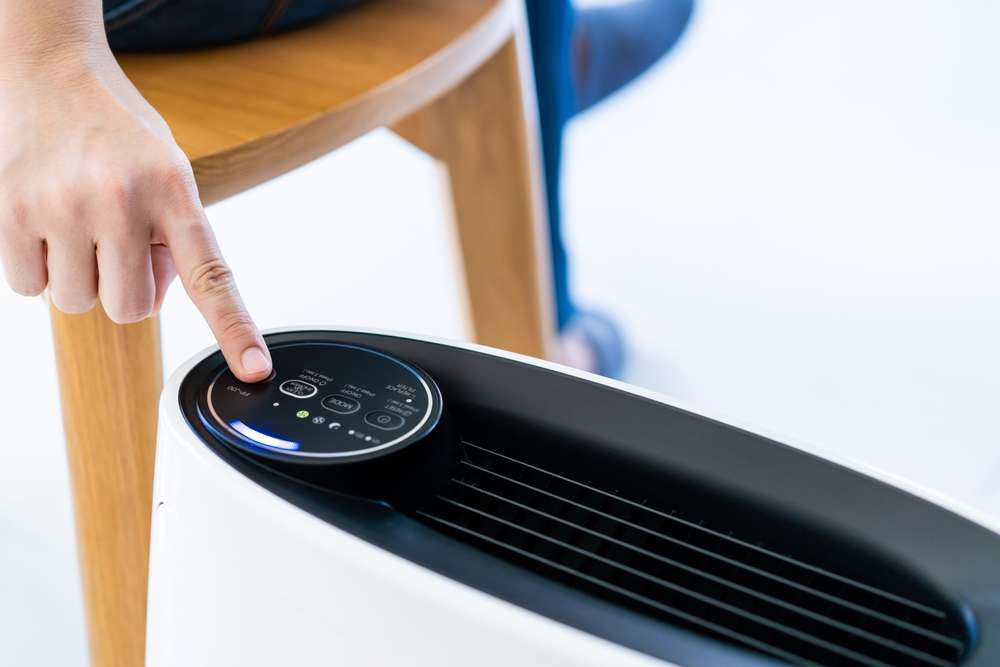Who doesn’t like things to cost less and be more efficient at what they do? Air purifiers are already great at removing pollutants from the air, but does that benefit come at the cost of too much energy? How much electricity does an air purifier use anyway?
The answer is, it depends on what kind of air purifier you have, how often you run it, and at what setting you run it. All of these can have an impact on how much it costs to run the air purifier, but in general, most air purifiers run between 40 and 200 watts, which is how much they’d use per hour, measured in watt-hours.
Measuring Electricity Usage

Electricity is measured in watts or W. Electricity usage is not measured in watts though, it’s measured in watt-hours or Wh. To make this even more confusing, your electricity bill most likely shows the cost measured in kilowatt-hours, or kWh. Thankfully, explaining this is pretty easy.
Watts is how much power a device needs to function. Watt-hours is how many watts that device uses per hour. So, if your air purifier is a 50-watt device, and you ran it for six hours, that would come out to 300 watt-hours. But electricity bills measure electricity usage in kilowatt-hours.
The reason is that they’re showing the cost of providing electricity to an entire house, including all the devices drawing electricity from that house. So, if the air purifier’s electricity usage was separated on the bill, you’d see it measured as 0.3 kWh.
Do Air Purifiers Use A Lot Of Electricity

Here is where the answer to “how much electricity does an air purifier use” gets a little tricky. The first thing to consider is just how long you plan to run an air purifier. Make sure to run them all day to be as effective at cleaning the air as possible. This will increase your electric bill every month, though.
The second thing to consider is your air purifier settings. For example, if an air purifier has different fan settings, at what speed are you running that fan? The higher the settings for your air purifier, the more it’s going to cost to run it, but also the more air it can take in overall.
Another thing to consider is how big or how much square footage your air purifier is intended to cover. Larger air purifiers that cover more square footage are going to cost more, especially if they’re whole-house air purifiers. Smaller ones, not so much.
Some air purifiers are also just built better than others. Some will have better-quality components and newer models are likely to have more features.
Energy Usage for Common Appliances
For reference, here is a list of how many kWh per year common appliances you’d find at home use.
| Appliance | Time in use | kWh / year |
|---|---|---|
| Aquarium | 24 hours/day | 700 |
| Iron | 1 hour/week | 52 |
| Clock radio | 24 hours/day | 44 |
| Microwave oven | 2 hours/week | 89 |
| Coffee maker | 30 minute / day | 128 |
| Radio (stereo) | 2 hours/day | 73 |
| Clothes washer (does not include hot water) | 2 hours / Week | 31 |
| Refrigerator (frost-free 16 cubic feet) | 24 hours/day | 642 |
| Dishwasher (does not include hot water) | 1 hour/day | 432 |
| Refrigerator (frost-free 18 cubic feet) | 24 hours/day | 683 |
| Dehumidifier | 12 hours/day | 700 |
| Television (color) | 4 hours/day | 292 |
| Electric blanket | 8 hrs / day,120days / yr | 175 |
| Toaster oven | 1 hour/day | 73 |
| Fan (window) | 4 hrs / day,180days / yr | 144 |
| VCR | 4 hours/day | 30 |
| Fan (furnace) | 12 hrs / day,120 days / yr | 432 |
| Vacuum cleaner | 1 hour/week | 38 |
| Fan (whole house) | 4hrs / day, 120 days / yr | 270 |
| Water heater (40 gallons) | 2 hrs / day | 2190 |
| Hairdryer | 15 minutes / day | 100 |
| Water pump (deep well) | 2 hrs / day | 730 |
| Heater (portable) | 3 hours / day,120 days / yr | 540 |
| Water bed (no cover) | 12 hrs / day,180 days / yr | 620 |
Source: Consumer Energy Information
Energy Usage for ENERGY STAR Certified Appliances
A typical and more efficient air purifier, according to ENERGY STAR, is over 25% more energy-efficient.
A standard room air purifier, operating continuously, uses approximately 450 kWh per year in electricity. This is more than the energy used by some new refrigerators!
ENERGY STAR certified room air purifiers are over 25% more energy-efficient than standard models, saving consumers about 120 kWh/year and $15 annually on utility bills. These savings could add up to $120 over its lifetime!
ENERGY STAR
Ultimately, how much electricity an air purifier uses depends on these and other factors. To translate all that information into cost though we have to do some quick math.
How To Calculate Electricity Usage And Cost

A Quick Reminder
Anything calculated using this formula is just an estimate, so please supplement these numbers with your research. Also, keep in mind that these numbers don’t include the costs of actually purchasing an air purifier or of replacing filters or parts.
Cost Formula
The U.S. Department of Energy provides a nice, easy way to calculate the cost of running an electrical device. For more detailed information, we recommend you check out their cost calculation page, but we’ll give you a quick rundown too.
First, you’ll want to estimate the time, the number of hours, you use the device per day. Next, figure out how many watts the device uses, which can be found on the product or in the accompanying manuals. Multiply those two together and divide them by 1,000 to get their kilowatt-hours per day.
Take that number and multiply it by the number of days you use the device per year and you have your annual energy used by that device. To calculate the cost, you’d take that number and multiply it by cents per kilowatt-hour, which varies from country to country and state to state.
As an example, say that your air purifier runs at 80 watts (most air purifiers run between 40 and 200). And, let’s say that you do run the air purifier all day, every day, which means you’d be running it for 24 hours a day, 365 days a year. For daily energy usage, the formula would look like this:
( 80 x 24 ) ÷ 1,000 = 1.92 kWh
For annual energy usage, you would multiply that amount by 365 to get 700.8. If you lived in Germany and the cost was $0.37 per kilowatt-hour, then you’d multiply that by 700.8 to get a $259.30 energy cost for the year.
Do I Really Need An Air Purifier?
The answer to this question all depends on what you want out of an air purifier. If you want a home with cleaner, healthier air, then absolutely yes. If you’re looking for this on the cheap, there are certainly air purifiers that offer less expensive ways to do this, but, again, it all depends on what you think you can afford.
Consider looking for a smaller air purifier if your needs for one aren’t that high. You can reduce how many watts it uses by running it on lower settings. You also don’t have to run an air purifier all day either. It is worthwhile as well to look for an air purifier that uses its energy efficiently, as not every model will do so.
In Summary: How Much Electricity Does An Air Purifier Use?
Air purifiers are going to use electricity no matter what model you go with. It’s an unfortunate fact of those machines that we can’t avoid. However, with the right research and careful planning, you can make an air purifier an investment that will pay off far more than it takes out of your bank account.
How much electricity does an air purifier use though? That depends on many factors, such as how big it is, what settings you’re running it at, and its design efficiency. To calculate the cost, you’ll have to figure out its watts and the cost of electricity for where you live.
Either way, an air purifier will help clean up your air, you just have to decide if that health benefit is worth the cost.
What do you think about all this though? Have you had luck in keeping electricity costs low? What are your tips? Let us know in the comments below!

